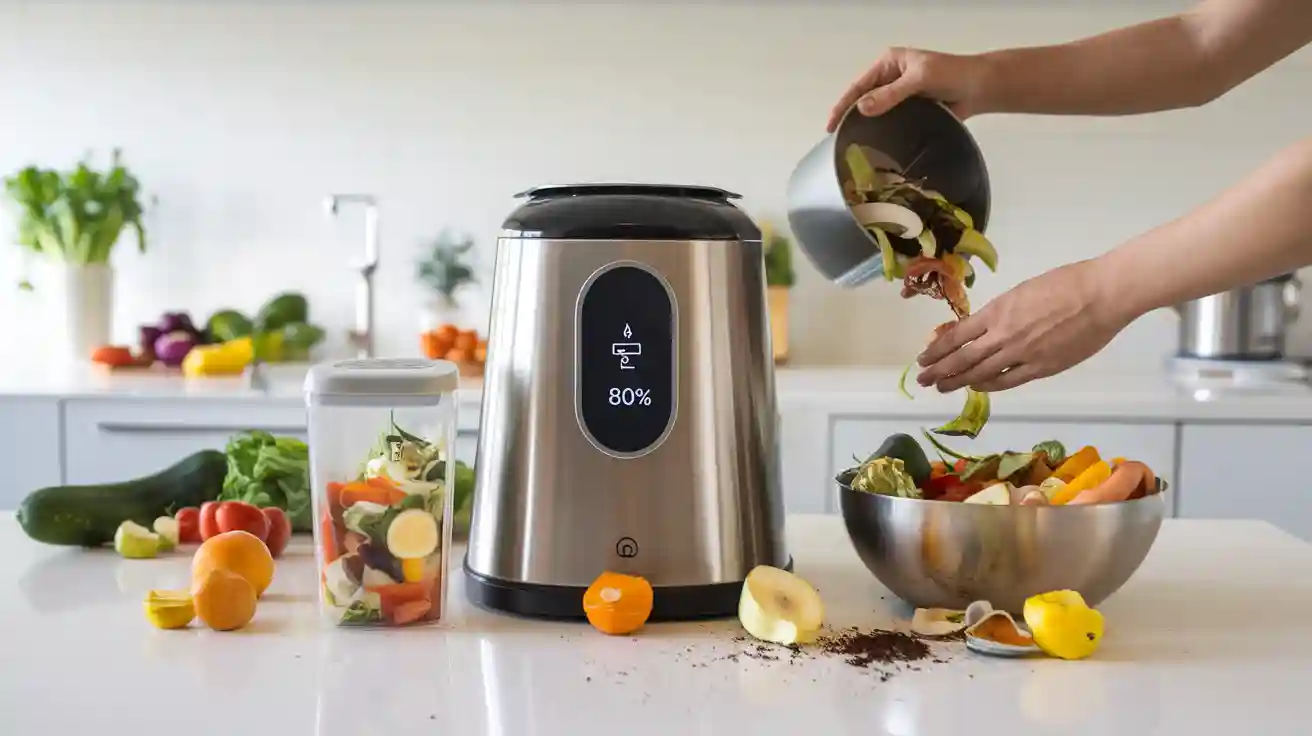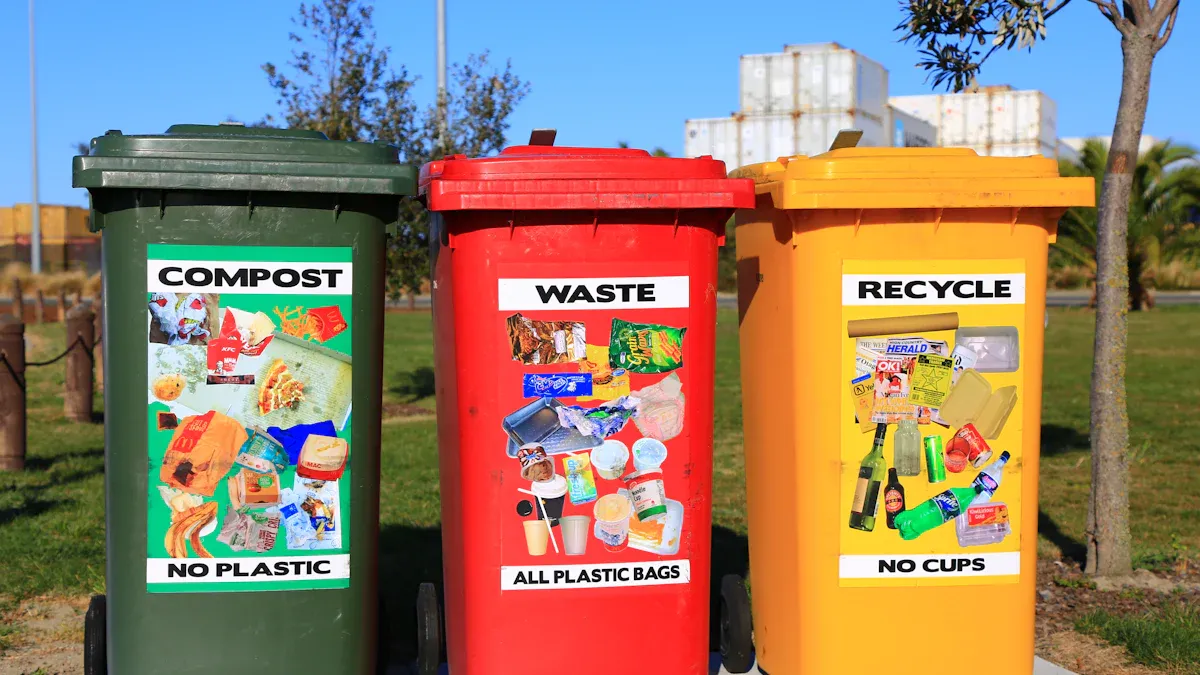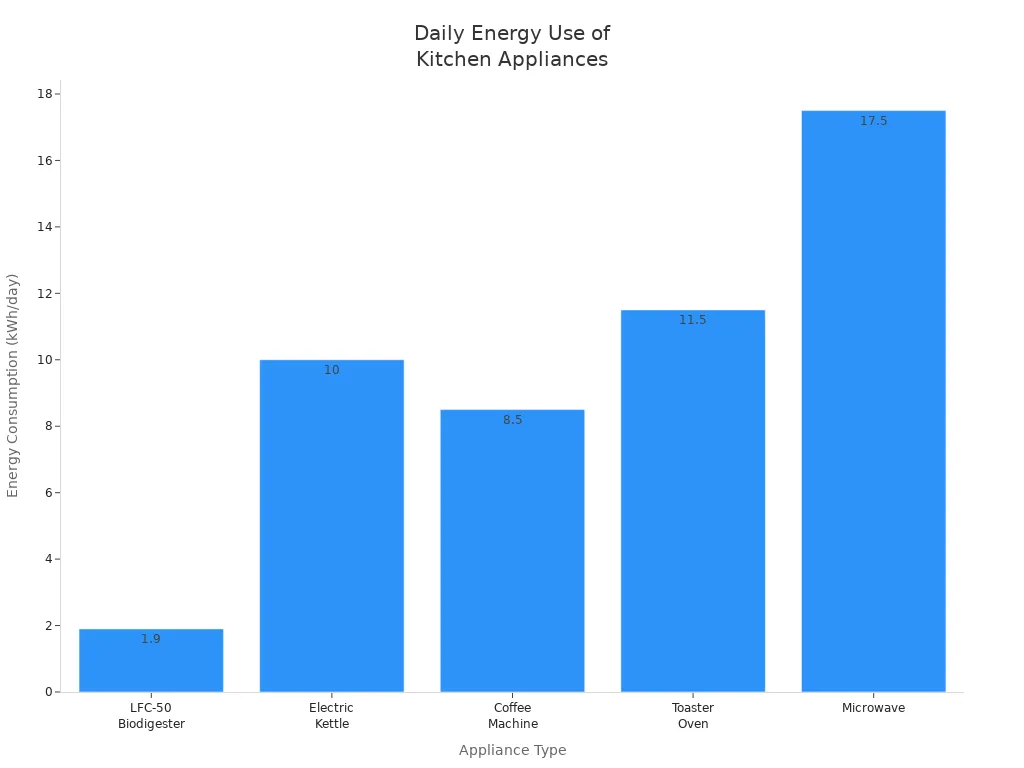
You toss out food scraps every day, but an electric composter for kitchen use can shrink that pile by up to 80%. Many city dwellers now choose these devices because they fit small spaces and work fast. Users see less trash, fewer odors, and a cleaner kitchen with little effort.
Electric composter for kitchen: How It Works and Why It’s Effective
Rapid Food Waste Reduction Technology
You might wonder how an electric composter for kitchen use can shrink your food waste so quickly. These devices use a mix of smart technology and heat to get the job done. Instead of waiting weeks for traditional composting, you see results in just a few hours.
Here’s what happens inside:
- The machine uses a strong heating element to raise the temperature to about 160°F. This heat removes moisture from your scraps and kills germs.
- A grinding or tumbling system breaks down the food into small pieces. This helps the heat reach every bit, making the process even faster.
- Some models use ultrahigh temperature technology to dry out the waste. Others add an intelligent grinding system to make sure nothing gets left behind.
Tip: Most electric composters can handle a wide range of kitchen scraps, including meat, fish, eggs, dairy, and even small bones. Just check your model’s guide for any exceptions.
You can see the difference in just 2-4 hours for drying and weight reduction. If you want to turn the dried waste into fertilizer, some machines offer a longer fermentation cycle that takes about two to three days.
Simple Operation and Odor Control
Using an electric composter for kitchen waste feels easy. Most models have a single button. You just load your scraps, press start, and let the machine do the rest. Some even have smart sensors that adjust the settings based on what you put inside.
Here’s what makes them so user-friendly:
- Automatic notifications tell you when it’s time to empty the bin.
- The activated carbon filter traps smells, so your kitchen stays fresh.
- Maintenance is simple. Cut your scraps into smaller pieces, clean the bucket after each cycle, and replace the filter every few months.
Note: Regular cleaning and not overfilling the bucket help your composter work its best. Always unplug before cleaning or changing the filter.
Many users say they love how these machines keep their kitchens odor-free and tidy. You don’t have to worry about fruit flies or bad smells.
Real Numbers: 80 Percent Less Waste
The biggest win? You see up to 80 percent less food waste going into your trash. That means fewer trips to the dumpster and a smaller impact on the environment.
Let’s look at what you can put in your electric composter for kitchen use:
| Food Waste Type | Accepted by Most Models? | Notes |
|---|---|---|
| Meat | Yes | |
| Fish | Yes | |
| Eggs | Yes | |
| Dairy | Yes | |
| Bones | Some (not all) | Check your model’s guide |
You get a dry, shelf-stable output that you can use in your garden or add to your compost pile. The process uses about 1 to 1.5 kWh per cycle, which is similar to running a microwave for an hour.
Did you know? Some models let you add scraps at any time, so you don’t have to wait for one cycle to finish before starting another.
With an electric composter for kitchen use, you take control of your food waste. You save space, cut down on odors, and help the planet—all with the push of a button.
Electric composter for kitchen: Space-Saving Benefits and Urban Living Advantages

Compact and Countertop-Friendly Designs
You want a device that fits your kitchen, not one that takes it over. Most electric composters for kitchen use come in compact sizes, perfect for city apartments or small homes. Many models sit right on your countertop, blending in with your other appliances. You can find units that measure about 13 inches long, 10 inches wide, and 13 inches high. They usually weigh around 25 pounds and hold up to 4 liters of food scraps.
| Specification | Details |
|---|---|
| Dimensions (LxWxH) | 13.2 x 10 x 13.4 inches |
| Weight | 25.4 pounds |
| Capacity | 4 Liters |
Manufacturers design these composters to fit tight spaces. You get narrow shapes and neutral colors, so the machine looks good in any kitchen. Some models even run as quietly as a refrigerator, so you barely notice them.
Practical Benefits for Small Spaces
Living in a small apartment or home means every inch counts. An electric composter for kitchen use helps you save space in several ways:
- You don’t need a backyard or patio for a compost pile.
- The machine sits on your counter or floor, so you can compost indoors.
- You avoid bulky manual compost bins or tumblers.
- The composter reduces the amount of trash you store, freeing up space under your sink or in your trash can.
You also get a cleaner kitchen. These machines use carbon filters to trap odors, so you don’t have to worry about bad smells. Some models let you add scraps during operation, which makes daily cleanup easier. You might need to empty a small unit more often, but you’ll notice less food waste piling up.
Tip: Choose a spot near an outlet and away from direct sunlight. This keeps your composter running smoothly and your kitchen organized.
Choosing the Right Model for Your Home
Picking the best electric composter for your kitchen depends on your space, family size, and cooking habits. Here’s what you should look for:
- Size: Check the height and width. Countertop models usually stand 10-14 inches tall. Larger floor models can reach up to 26 inches.
- Capacity: Smaller units (2.5-4 liters) work well for 2-4 people. Bigger families or frequent cooks might need a larger bin.
- Cycle Time: Some composters finish in just 2 hours. Others take up to a day. Faster cycles mean you can compost more often.
- Odor Control: Look for machines with carbon filters or deodorizing systems.
- Ease of Use: Simple controls, easy cleaning, and the ability to add scraps during a cycle make life easier.
- Waste Types: Some models handle meat and small bones, while others do not. Always check the manual.
Here’s a quick look at some popular models:
| Model | Size (Height) | Key Features & Performance | User Experience & Notes |
|---|---|---|---|
| Reencle Prime | 18 inches | Efficient, quiet, produces stable compost | Most recommended for performance and compost quality; quiet and versatile size |
| Lomi Classic | 12 inches | Compact, affordable, batch processing | Smaller bucket, noisier, requires cleaning after each use |
| Mill Kitchen Bin | 26.8 inches | Largest capacity, subscription-based | Bulky, subscription model, output not true compost |
| Vitamix FoodCycler FC-50 | Slightly larger than Lomi | Compact, transparent about limitations | Less effective final product compared to Reencle; better user experience with Reencle |
Many experts and users recommend the Reencle Prime for its quiet operation and high-quality compost, even though it costs a bit more.
Real-Life Success Stories from Urban Users
People living in cities often face challenges like limited space, noise, and the need for easy cleanup. Urban users share both struggles and solutions:
| Challenges (Cons) | Solutions / Positive Aspects (Pros) |
|---|---|
| Selective waste acceptance requiring sorting | Convenient countertop integration and eco-friendly waste transformation |
| Mechanical malfunctions and technical issues | Efficient composting process encouraging sustainable living |
| Odor control concerns | Use of charcoal filters, odor-neutralizing agents, and proper ventilation |
| Space constraints in urban kitchens | Compact, quiet, and countertop-friendly designs suitable for apartments |
| Need for regular maintenance and waste sorting | Balanced compost material ratios to prevent odors and improve compost quality |
You might worry about sorting waste or dealing with smells, but most users find that regular cleaning and using the right filters solve these problems. Many city dwellers say their kitchens feel cleaner and less cluttered. They love turning food scraps into something useful for houseplants or community gardens.
You also save energy. Electric composters use less power than most small kitchen appliances. Take a look at this chart:

You see that a kitchen composter uses much less energy than a microwave or toaster oven. This makes it a smart choice for eco-friendly living in the city.
You can tackle food waste and space issues in your city kitchen with an electric composter for kitchen use.
- It fits small spaces and keeps odors away.
- You cut waste by up to 80%.
Make your kitchen cleaner and greener—choose a composter for a simple, eco-friendly lifestyle.
FAQ
How much noise does an electric composter make?
Most electric composters run quietly. You might hear a soft hum, like a fridge. You can use it day or night without disturbing anyone.
Can you compost all food scraps?
You can add most food scraps, like veggies, fruit, meat, and dairy. Some models do not handle large bones or lots of oil. Always check your manual.
What do you do with the finished compost?
You can sprinkle the dry output on houseplants or mix it into garden soil. Some people add it to a larger compost pile for richer fertilizer.


